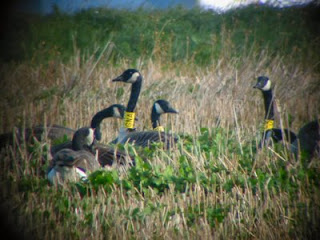 Back on in early October, after I'd spent most of a day on the road, a co-worker at the office told me that "some guy had called about some rare birds down in Bridgewater"... I pressed for more info, but, it was not forthcoming... No name, no number, no species....
Back on in early October, after I'd spent most of a day on the road, a co-worker at the office told me that "some guy had called about some rare birds down in Bridgewater"... I pressed for more info, but, it was not forthcoming... No name, no number, no species....Then this week I was emailing with Ken Lamb and he inquired if I had seen the pictures of the cranes that local guide, Dave Hentosh had of Sandhill Cranes in Bridgewater (!)

Of course, I followed up and David obligingly sent over these great pictures taken by one of his clients. The photos show four Sandhill Cranes feeding in a field of grain stubble. Mars Hill can be seen in the background of one.
Though this species now breeds in south-central Maine, there are few records of Sandhills for northern Maine. Locally, Great Blue Herons are usually referred to as "cranes" and there are plenty of reports of these in late summer and fall... but the real deals are quite rare. The last one I recall, was a single crane found by Arlen Lovewell in Ashland in the spring in the mid 1990's.
As for the collared Canada Geese from Greenland, Connie Michaud wrote to say that they were still around the area and that her husband had located at least four of them. The marked geese were seen on Sunday the 19th in a field along in Caribou Lake Road just south of Caribou.

David Stroud, one of the goose researchers who originally marked the birds, also sent along some great pictures of "my" geese taken when they were originally captured in Greenland this summer. Since the group was studying head and bill shape in an effort to determine which subspecies of Canada geese they were capturing, they had wonderful mug shots of all the geese we're now seeing in Caribou. Here's one of GNA.
David also sent a picture of "Lake Y" in western Greenland where the geese were caught last July. The Greenland icecap can be seen in the distance... looks chilly.
 I've had no luck relocating the Snowy Owl here in Woodland but have heard of a bunch more that have shown up in the region. Brian Dalzell in New Brunswick wrote that he had heard of three Snowy Owls arriving last weekend: one in Cape Race Newfoundland and two in New Brunwick. Louis Bevier noted that one was taken in by a bird rehabber from Jackman on the 14th and yet another has been reported down in Scarborough on Pine Point. Keep a lookout for more!
I've had no luck relocating the Snowy Owl here in Woodland but have heard of a bunch more that have shown up in the region. Brian Dalzell in New Brunswick wrote that he had heard of three Snowy Owls arriving last weekend: one in Cape Race Newfoundland and two in New Brunwick. Louis Bevier noted that one was taken in by a bird rehabber from Jackman on the 14th and yet another has been reported down in Scarborough on Pine Point. Keep a lookout for more!







